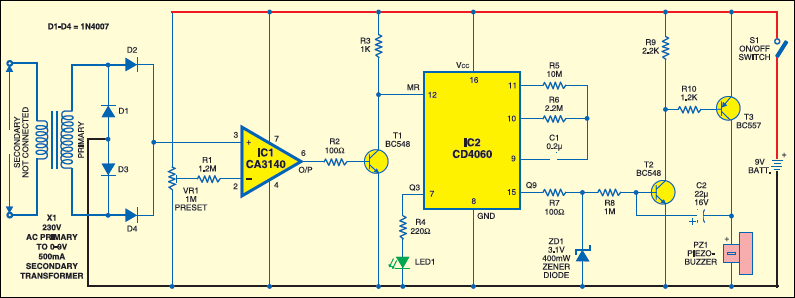 High wattage appliances like electric irons, ovens and heaters result in unnecessary power loss if left ‘on’ for hours unnoticed. Here is a current sensor circuit that senses the flow of current through the appliances and gives audible beeps every fifteen minutes to remind you of power-‘on’ status.
High wattage appliances like electric irons, ovens and heaters result in unnecessary power loss if left ‘on’ for hours unnoticed. Here is a current sensor circuit that senses the flow of current through the appliances and gives audible beeps every fifteen minutes to remind you of power-‘on’ status.
This is a non-contact version of current monitor and can sense the flow of current in high-current appliances from a distance of up to 30 cm . It uses a standard step-down transformer (0-9V, 500mA) as the current sensor. Its secondary winding is left open, while the primary winding ends are used to detect the current. The primary ends of the transformer are connected to a full-wave bridge rectifier comprising diodes D1 through D4. The rectified output is connected to the non-inverting input of IC CA3140 (IC1).
Current sensor circuit
IC CA3140 is a 4.5MHz BIMOS operational amplifier with MOSFET input and bipolar transistor output. It has gate-protected MOSFET (PMOS) transistors in the input to provide very high input impedance (1.5 T-ohms), very low input current (10 pA) and high speed switching performance.

The inverting input of IC1 is preset with VR1. In the standby mode, the primary of the transformer accepts e.m.f. from the instrument or surrounding atmosphere, which results in low-voltage input to IC1. This low voltage at the non-inverting input keeps the output of IC1 low. Thus transistor T1 doesn’t conduct and pin 12 of IC2 goes high to disable IC2. As a result, the remaining part of the circuit gets inactivated.
Circuit operation
When a high-current appliance is switched on, there will be a current drain in the primary of the transformer to the negative rail due to an increase in the e.m.f. caused by the flow of current through the appliance. This results in voltage rise at the non-inverting input and the output of IC1 becomes high. This high output drives transistor T1 into conduction and the reset pin of IC2 becomes low, which enables IC2.
IC CD4060 (IC2) is a 14-stage ripple counter. It is used as a 15-minute timer by feeding Q9 output to the piezobuzzer for aural alarm through the intermediate circuitry. Resistors R5 and R6 along with capacitor C1 maintain the oscillations in IC2 as indicated by blinking LED1. The high output from IC2 is used to activate a simple oscillator comprising transistors T2 and T3, resistors R8 and R10, and capacitor C2.
When the Q9 output of IC2 becomes high, zener diode ZD1 provides 3.1 volts to the base of transistor T2. Since transistor T2 is biased by a high-value resistor (R8), it will not conduct immediately. Capacitor C2 slowly charges and when the voltage at the base of T2 increases above 0.6 volt, it conducts. When T2 conducts, the base of T3 turns low and it also conducts. The piezobuzzer connected to the collector of T3 gives a short beep as capacitor C2 discharges. This sequence of IC2 output at Q9 becoming high and conduction of transistors T2 and T3 resulting in beep sound repeats at short intervals.
The article was first published in December 2007 and has recently been updated.









How to change the time from 15 minutes to 10 minutes